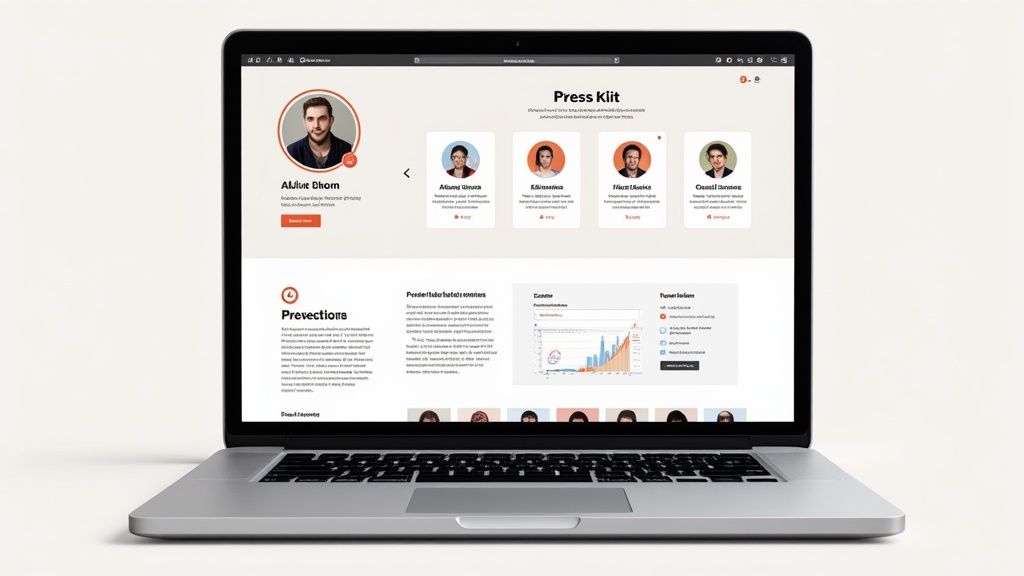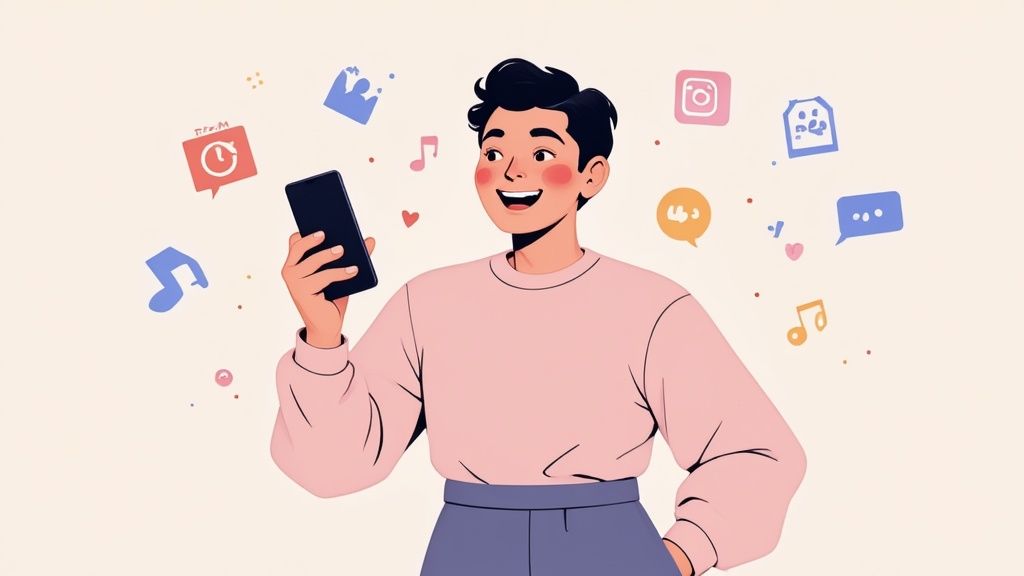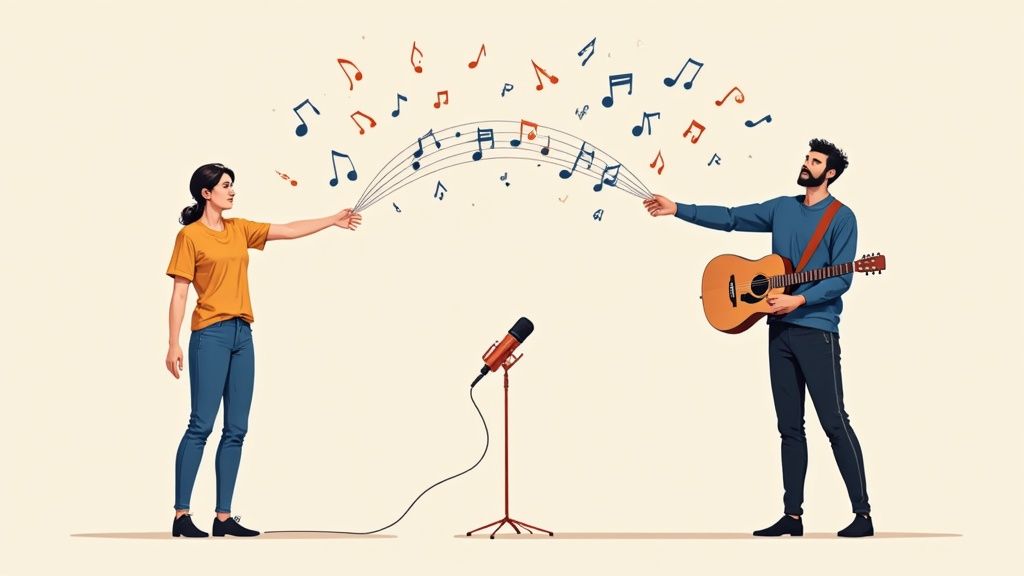Look, before you even think about dropping money on ads or spamming your new track everywhere, you need to get your house in order. Promoting your music online only works if you have a solid digital foundation first.
It’s like setting up a storefront before you run a grand opening sale. If people show up to a half-built, messy shop, they’re going to walk right out. The same thing happens when a potential fan clicks a link and lands on a confusing or dead-end page. You've lost them.
A strong digital foundation turns a fleeting moment of discovery into a real, lasting fan connection. It’s about creating a seamless world where your brand, your story, and your music all click together, no matter where someone finds you.
Let's start with your industry-facing tool: the Electronic Press Kit (EPK). This is your digital resume, built specifically for the people who can give you a signal boost—bloggers, playlist curators, venue bookers, you name it.
Their inboxes are flooded. A killer EPK saves them time by giving them everything they need, right then and there. A messy, incomplete EPK is an instant "no." Don't let that be you.
Here's a good example of how a clean EPK is structured. It gives anyone who lands on it a quick, clear overview of who you are and what you're about.

This layout makes total sense. It’s logical, easy to scan, and helps someone quickly grab your bio, music, and high-res photos without having to email you back and forth.
An effective EPK isn't just a folder of files; it's a strategic tool. It should tell your story at a glance and make it incredibly simple for someone to say "yes" to featuring you.
To really build out your digital presence, you might also look into specialized viral video marketing strategies for music. And don't forget where people are actually listening. Globally, fans spend an average of 18.4 hours per week listening to music, with Spotify and YouTube eating up most of that time. That stat alone tells you why a polished presence on these platforms is non-negotiable.
Social media is crucial, but you’re just renting space there. You don't own your followers. Your artist website is the only online real estate you truly control. Think of it as the central hub of your entire career.
Every other promotional effort—from a TikTok video to a Spotify pre-save link—should ultimately point people back to your website. It's your home base.
Make sure your site is clean, mobile-friendly, and dead simple to navigate. It absolutely must have:
One last thing—and this is critical. Make sure your music sounds professional everywhere it’s heard. All the promotion in the world can't save a track that sounds amateurish. A bad mix or master can undo all your hard work. Nail the final polish on your tracks by learning about the ideal audio mastering chain. A strong foundation means looking and sounding your best.
Forget using social media as a digital billboard for "new song out now" posts. That's not what it's for. Think of it as a living, breathing space to build a community of people who actually care about your journey. The goal is to stop broadcasting and start connecting. Give them a reason to follow you that goes way beyond just the music.
Authenticity is your biggest weapon here. If you’re a bedroom producer who nerds out over vintage synths, show it! Post a quick clip of you dialing in a killer sound or a photo of your wonderfully messy creative space. People connect with the person behind the music, not a faceless promo account.

This is how you turn casual listeners into die-hard supporters who are genuinely invested in your success. They become the ones who don't just stream your new release—they share it with their friends because they feel like they're part of your story.
Right now, platforms like TikTok and Instagram Reels are the most powerful discovery engines you have. But the trick isn't just to slap your song onto a random video. You need to create content that shows off your personality and makes people want to engage.
You don't need a massive production budget. Honestly, raw and unfiltered content often does better. It's more about having a plan. Think about creating a few content "pillars" you can rotate through:
This strategy gives you a consistent way to post without the constant pressure to "go viral." You're building a narrative around your music, making each release feel like the next chapter in a story your fans are following along with.
Your social media should feel less like an advertisement and more like a backstage pass. Let fans into your world, show them the process, and make them feel like insiders.
To really dial in your approach, you need to think about what works best on each platform. They all have their own vibe and audience expectations.
Here's a breakdown of content types that perform best for musicians on key social media platforms, helping you tailor your promotional efforts for maximum impact.
By tailoring your content, you're not just shouting into the void; you're speaking the native language of each platform and giving yourself the best shot at getting noticed.
Public posts are fantastic for discovery, but the real, lasting connections are built in more private spaces. This is where you can cultivate a core group of super-fans—the ones who will become your most powerful advocates.
A dedicated Discord server, for example, can become your digital fan club. It's the perfect place to offer exclusives like early song previews, host candid Q&A sessions, or even get feedback on new ideas. In the same way, a private Facebook Group can create a tight-knit community where fans can connect with you and, just as importantly, with each other.
These channels aren't about reaching thousands of new people. They’re about strengthening the bond with the fans you already have, making sure they stick around for the long haul. This is a critical piece of promoting your music online because it builds a sustainable foundation for your career, one dedicated fan at a time.
Getting your music onto streaming platforms is one thing. Getting it heard is another challenge entirely.
It’s easy to feel like you’re just dropping your tracks into a black hole when millions of other songs are uploaded every single day. But here’s the secret: you can’t just treat Spotify and Apple Music like digital storefronts. You have to learn how to work their ecosystems.
First things first, and this is non-negotiable: claim your artist profiles. Go get your Spotify for Artists and Apple Music for Artists accounts set up right now. This is ground zero. It’s how you take control of your branding, update your bio and photos, and—most importantly—get access to the backend tools you'll need to actually pitch your music and see who's listening.
This simple flow breaks down the core strategy for making an impact.

From claiming your turf to getting your fans involved, each step is designed to catch the attention of the platform's algorithms.
Once your profiles are squared away, your sights should be set on editorial playlists. We’ve all heard the stories—landing a spot on a major playlist like New Music Friday can completely change an artist's trajectory overnight. The good news is, Spotify gives you a direct line to their editorial team through your Spotify for Artists dashboard, letting you pitch one unreleased song at a time.
You only get one shot per release, so you have to make it count. Here’s how you give yourself a real fighting chance:
A thoughtful, well-prepared pitch immediately signals that you're a professional who gets it. It makes a curator's job easier, and that alone puts you way ahead of the artists who just upload and hope for the best.
Getting on a major playlist is a numbers game, but a detailed pitch massively improves your odds. It's the difference between buying a lottery ticket and actually having a strategy.
And there's a good reason to focus here. As of 2024, streaming pulls in a massive 69% of global recorded music revenues, which translates to over $20.4 billion. For any indie artist, that number screams one thing: mastering these platforms is no longer optional if you want to find a global audience and make a living.
While the big editorial playlists get all the hype, it's often the algorithmic ones—like Discover Weekly and Release Radar—that drive the most consistent, long-term streams. These playlists are different for every single user, and they're triggered by data signals. Your mission is to create those signals.
The single most effective way to do this is by creating a "release day spike." You need to drive as much listening and engagement as you possibly can within the first 24-48 hours of your song going live.
Pre-save campaigns are brilliant for this. They automatically add your new track to your fans' libraries and playlists the second it drops, which creates an immediate surge of activity.
Beyond that, you need to rally the troops. Get your followers on social media to stream, save, and share your track as soon as it's out. That initial burst of data tells the platform's algorithm that people are paying attention, making it far more likely to get pushed out to new listeners.
Want to see this in action? We did a full breakdown of how Lilo Key gets 90,000 monthly listeners on Spotify, and it’s a masterclass in triggering the algorithm.
Relying solely on your own channels is a slow grind. Let's be real—the real momentum kicks in when other people start talking about you. This is where getting strategic with your outreach and partnerships becomes your secret weapon for cutting through the noise.
You can't do it all yourself. Getting a co-sign from a trusted voice—a blog, a playlist curator, another artist—is invaluable for reaching entirely new audiences.
This means you’ve got to think beyond just making music. You need to actively hunt for features, reviews, and collaborations. To really make a dent, it helps to understand what is digital PR is all about. It’s not about spamming your SoundCloud link; it’s about building genuine relationships and giving curators something their audience will actually love.

First things first: identify the right blogs, YouTube channels, and online radio stations for your specific sound. Forget trying to land on Pitchfork right out of the gate. The goal is to find curators whose audience is a perfect match for your music.
A great way to start is by seeing where artists similar to you are getting featured. Make a list.
Once you have your targets, it’s time to craft a personalized pitch. Generic, mass emails are deleted on sight. You have to show you've actually paid attention to what they do.
Here’s a simple but effective way to approach it:
This kind of respectful, tailored approach shows you value their time and dramatically increases your chances of getting a listen.
A great pitch isn't about begging for a feature; it's about offering a curator great new content that their specific audience will genuinely appreciate.
Beyond the media, partnerships are a fantastic way to cross-pollinate fanbases. Hopping on a track with another musician is a classic win-win. Both of you get introduced to a new set of dedicated listeners who are already primed to like what you do.
But don't just stop at other musicians.
Think about content creators and influencers whose whole vibe aligns with your music. A gaming streamer might need some fresh background tracks for their live sessions. A lifestyle vlogger could feature your song in their next travel montage. These placements often feel more organic and authentic to their audiences than a traditional ad ever could.
You can start small here. Reach out to nano-influencers (creators with under 10,000 followers) who have super-high engagement rates. They're often way more accessible and excited to partner with emerging artists. A simple collaboration can put your sound in front of thousands of potential new fans, creating an authentic discovery moment that no algorithm can replicate.
Look, social media is an amazing tool for getting discovered. No question. But at the end of the day, you're building your career on borrowed land.
Algorithms change on a whim, accounts get shadowbanned for no reason, and entire platforms can just... fade away. Remember Myspace? Exactly. The only asset you truly own and control is the direct line to your biggest supporters: your email list.
Think of it as your insurance policy against the chaos of the internet. It's a direct, unfiltered channel to the people who actually care about your music. This becomes your secret weapon for launching new tracks, announcing shows, and selling merch without praying the algorithm shows your post to anyone.
So how do you get fans to actually hand over their email? It’s simpler than you think. You just need to offer them something valuable in exchange—a good reason to join your inner circle. This little bribe is often called a lead magnet.
You don't need to overthink it. Offer simple, high-value incentives that won't take you forever to create:
The trick is to offer something that feels exclusive, like they're part of a club. If you need more inspiration, we have a guide on the top lead magnets for audio engineers and music producers that can spark some great ideas.
Your email list isn't just another marketing channel; it's your private fan club. Treat every single subscriber like a VIP, and they'll become the true backbone of your career.
Once people are on your list, don't let it go cold. Your newsletters should feel like a personal update from you, not some corporate marketing blast.
Share your journey. Be real. Tell stories. Talk about a recent studio session, a moment of inspiration, or even a challenge you're wrestling with. That's the stuff that builds a real connection.
This direct line is more critical than ever. The streaming world is insanely crowded, with global subscriptions hitting 667 million by 2023. Standing out in that sea of noise means creating a personal experience that makes fans feel like they know you. Your email list is the single best tool for that. You can dig into more of these music streaming market trends to get the full picture.
Ultimately, you're playing the long game here. The goal is to build relationships that turn casual listeners into die-hard fans who will stick with you for years.
Even the best-laid plans run into questions. When you're in the thick of it, trying to get your music heard, a few common hurdles always seem to pop up. Let's tackle them head-on.
This is the big one, right? There's no magic number, but I always tell artists to start with the 10-20% rule.
Look at what you spent to create the track—recording, mixing, mastering, all of it. For every dollar you put into production, plan on spending 10 to 20 cents on promotion.
If your song cost $500 to make, that means having a $50-$100 promo budget. That’s a realistic starting point for a small social media ad campaign or a few targeted playlist submissions. It gets the ball rolling.
Of course, this isn't set in stone. If you went all out and shot a killer music video, you'll want to put more money behind it to make sure people actually see it. The key is to stop thinking of promotion as just another cost. It's an investment in the art you've already poured your heart into.
For almost every new artist I talk to, the answer is the same: singles. The way people listen to music has changed. It’s all about a steady flow of content, not a massive project drop once a year.
Releasing singles just works better in today's world. Here's why:
Think of each single as a new chapter in your story. This steady approach builds a more engaged and loyal following over time than dropping a full album once a year into silence.
You don't need a Michael Bay-level production for every song, but you absolutely need video content. Video runs the internet, period. Putting a song out there without some kind of visual is like showing up to a party invisible.
I suggest a tiered approach. Your main, "flagship" single? Yeah, that one probably deserves a proper, full-fledged music video.
For everything else, get creative with more accessible video assets:
The goal is to have something visual for YouTube, Instagram Reels, and TikTok. A static album cover just isn't going to grab anyone's attention in a sea of scrolling content. Your music promotion strategy has to be seen, not just heard.
Ready to make sure your tracks sound incredible everywhere, especially in the car? CarMaster uses AI specifically designed to optimize your music for automotive sound systems, ensuring clean bass and perfect clarity. Get a free, instant preview and hear the difference for yourself. Master your song now at CarMaster.